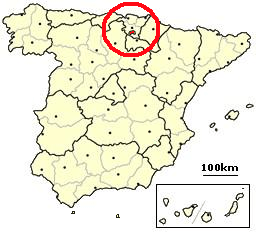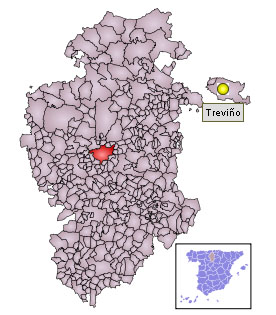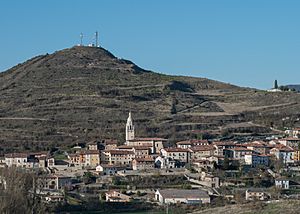Treviño facts for kids
Quick facts for kids
Treviño
|
|
|---|---|

Location of Condado de Treviño in Spain. Treviño is the capital of Condado de Treviño.
|
|
| Country | Spain |
| Autonomous community | Castile and León |
| Province | Burgos |
| Municipality | Condado de Treviño |
| Population
(2008)
|
|
| • Total | 202 |
| Time zone | UTC+1 (CET) |
| • Summer (DST) | UTC+2 (CEST) |
| Official language(s) | Spanish |
Treviño (also known as Trebiñu in Basque) is a small town in Spain. It is the main town of the Condado de Treviño area. This area is part of the province of Burgos, which is in the Castile and León region.
What makes Treviño special is its location. The Condado de Treviño, along with a smaller area called La Puebla de Arganzón, forms an enclave. This means it's a piece of land that belongs to one area (Burgos) but is completely surrounded by another area (the Álava province). Álava is part of the Basque Country. So, Treviño is like an island of Burgos within Álava!

Contents
Treviño's Long History
People have lived in the Treviño area for a very long time. We know this because many ancient remains have been found there. Before the Romans arrived, different tribes like the Varduls, Caristios, and Autrigones lived here. This shows that the area was important, perhaps for trade or travel.
Around the early 1000s, small communities started to form near the Ivita river. This river is now known as the Ayuda River. The name Treviño might come from a Latin word, Trifinium. This word means 'boundary of the three tribes', which fits the area's history.
How Treviño Town Began
The oldest written record mentioning this area is from 1025. It's a document called the Reja de San Millán. It talks about "XXXV regas," which means 35 irrigated fields. This suggests it was a very important farming area.
The town of Treviño itself was officially started by a king. King Sancho VI of Navarre, also known as "the Wise," founded it. This happened no later than 1161, and some people think it was as early as 1151. The exact date isn't known because the original document is lost. However, it was founded around the same time as other nearby towns. This shows that the kings of Navarre, not Castile, controlled the area back then.
When Castile Ruled Treviño
Around 1199–1200, the area was taken over by Alfonso VIII of Castile, a king from Castile. Even after this, the area was still seen as part of Álava for a while.
Over time, the town of Treviño grew more important. In 1254, Alfonso X of Castile gave the town special rights, called fueros. These rights helped the town develop. Slowly, people started calling the area "de Treviño" instead of its old name, "de Uda." For about 100 years, it was even known as "Treviño de Uda."
When Treviño became part of Castile, it was directly controlled by the king. It wasn't like some other areas that could choose their own local leaders. In 1332, a group called the Cofradía of Álava officially agreed that Treviño and its surrounding lands belonged to the king.
Later, in 1366, Henry II of Castile gave Treviño and its villages to a noble named Pedro Manrique I de Lara. This was a reward for his help. In 1453, Pedro's great-grandson, Gómez Manrique, was given the title of count. This is how the area became known as the Condado de Treviño (County of Treviño).
The family continued to be important. In the 1500s, these counts built a grand palace in Treviño. Today, this palace is the town hall, called the ayuntamiento.
So, Treviño became the home of a powerful noble family. It was located right in the middle of Álava, surrounded by communities that had more freedom and their own local laws, typical of the Basque Country.
Fun Annual Events
Treviño has some cool festivals and events each year:
- Fiesta of San Juan Bautista: This festival celebrates the patron saint of Treviño. It happens on June 24th. If that day is a weekday, some of the fun activities are moved to the closest weekend.
- Feria de las Moscas ("Fly Fair"): This unique fair takes place on the first Sunday of July. But if July 1st is that Sunday, the fair is held on July 8th instead.
- The pilgrimage of San Formerio: This is a special journey to honor San Formerio, who is the patron saint of the whole Condado de Treviño area. It happens on the Sunday closest to September 25th. The journey ends at the Hermitage of San Formerio, a small church in Pangua, which is also in Condado de Treviño.
See also
 In Spanish: Treviño para niños
In Spanish: Treviño para niños



